Stephen Morris's Blog, page 2
August 15, 2023
Commandments #1-3
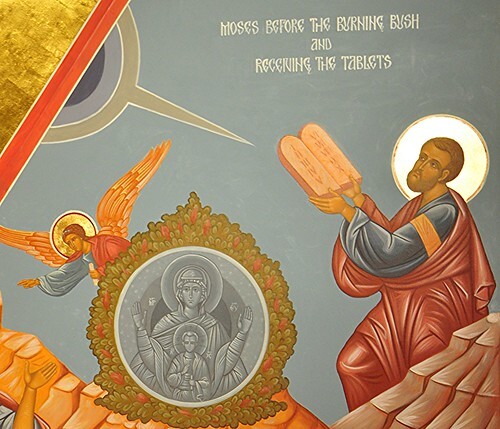 A contemporary icon showing the prophet and God-seer Moses at the Burning Bush and receiving the Ten Commandments, both of which happened at Mt. Sinai.
A contemporary icon showing the prophet and God-seer Moses at the Burning Bush and receiving the Ten Commandments, both of which happened at Mt. Sinai.Moses goes up into the smoke and fire and receives the Ten Commandments from God on Mt. Sinai. He has set a human barricade around the base of the mountain to insure that no “tourists” or sightseeing thrill seekers climb up the rocky heights behind him, hoping to see and hear what is intended only for Moses to see and hear. Even his brother Aaron, who goes partway up the mountain with his brother Moses, turns around and goes back to the bottom before Moses reaches his destination.
The first three or four commandments are commonly considered to describe our duty towards God; the following commandments are commonly thought to reveal our duty to our neighbors. It is these Ten altogether that the Early Church thought were eternal; the other commandments of the Old Testament—according to the Apostolic Constitutions, a 4th century Syrian handbook for how to run a parish church—says that the other Old Testament commandments were all given after the idolatry of the Golden Calf and all have to do with regulating the worship of Israel (how to worship, who can worship, what is worshipped, behavior that can get a person banned from participating in worship).
The most famous and controversial of these first three commandments is the commandment condemning idolatry. Most people think idolatry means worshipping statues but idolatry is really about letting anything be more important than God. Family, ideas, food, sex, drugs (alcohol included) can become idols if any of them are more important to us than God.
People often also think idolatry means worshipping devils and demons. St. Paul doesn’t think idolatry is about worshipping demons; he thinks idolatry is a waste of time because the “god” the statue represents doesn’t exist. According to St. Paul in First Corinthians, idolatry is the worship of a thing that isn’t real whereas worship of the true God is worshipping what really exists. That’s why he thinks it’s safe for a Christian to eat meat that was sacrificed to an idol; the meat wasn’t sacrificed to a devil but it was offered to something that doesn’t exist so it wasn’t really offered to anyone or anything.
That doesn’t mean that devils and demons don’t exist. The NYTimes had a fascinating article this weekend about the differences in religious power wielded by a Christianity that takes demonic power seriously vs. a Christianity that does not take demonic power seriously.
The post Commandments #1-3 appeared first on Stephen Morris, author.
August 8, 2023
Moses = Burning Bushes and Building Bridges
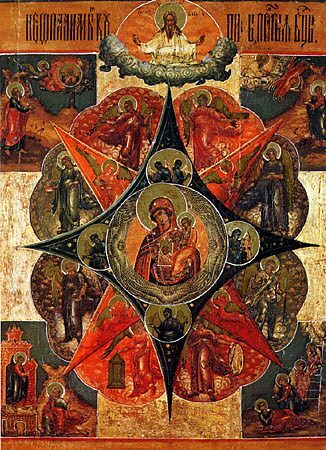
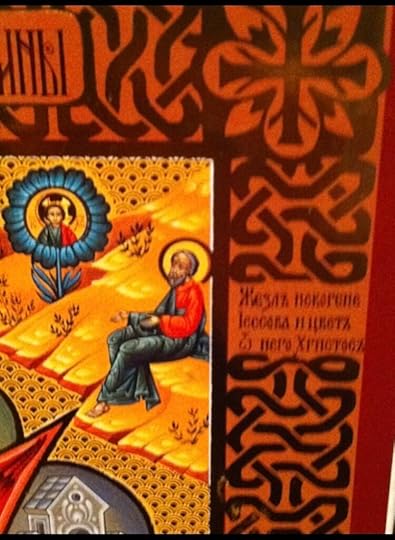 Moses encounters the Logos, the Word of God, at the Burning Bush in the icon of Our Lady of the Burning Bush in the upper right corner of the icon; see the detail from a contemporary icon as well.
Moses encounters the Logos, the Word of God, at the Burning Bush in the icon of Our Lady of the Burning Bush in the upper right corner of the icon; see the detail from a contemporary icon as well.Moses was the lynchpin between God and Israel; as the Serbian proverb goes, he was the neck that turned the head (connecting the head—God—to the body, which was Israel). His encounter at the bush, as he was tending Jethro’s flocks, becomes an image of the Incarnation as the bush that burned but was not consumed is a foreshadowing of the Virgin who gave birth to God without loss of her virginity.
According to Wikipedia (so it MUST be true!), the Hebrew word in the story that is translated into English as bush is seneh(סנה) which refers in particular to brambles; seneh is a biblical dis legomenon, only appearing in two places, both of which describe the burning bush. The use of seneh may be a deliberate pun on Sinai (סיני), a feature common in Hebrew texts. (That the burning bush is a bramble bush also associates it with the bramble bush which is an important part of the story of the sacrifice of Isaac in Genesis 22.)
At the bush, Moses is commissioned to act as God’s mouthpiece, telling Pharaoh to “Let my people go” and telling the people of Israel what God wants from them. He is commissioned to build a bridge between God and the world—both the fallen world (Egypt) and the world being redeemed and healed (Israel). This role as the bridge builder between God and the world is essentially the role of a priest; one Latin word for priest is pontifex, which is literally “bridge builder.”
Even before Aaron is ordained as priest, Moses offers sacrifices to God on behalf of Israel. Moses builds the bridge between eternity and the world by his words and by sacrifice. In the Middle Ages, it was an especially meritorious act to leave money in your will to build a public bridge that did not charge a toll across a river. Building a toll free bridge was a priestly act, uniting two sides of the river as a priest unites worlds in the liturgical sacrifice and preaching. (Without a bridge, people might have to travel several miles—hours—out of their way to find a place to cross the river. A toll bridge, built by someone who wanted to make a profit on their construction investment, limited river crossing to the well-to-do; a toll free bridge was an image of Christ’s sacrifice freely available to all.)
Moses built a bridge between God and Israel. Israel, the priestly people commissioned at Mt. Sinai, built a bridge between God and the world. The Word-made-flesh, who spoke to Moses at the bush, built the ultimate bridge that brought together everything he was not with everything that he is. The Church, the Body of the Word-made-flesh, continues that ministry of bridge building.
The post Moses = Burning Bushes and Building Bridges appeared first on Stephen Morris, author.
August 1, 2023
Jethro and Moses … and Christ
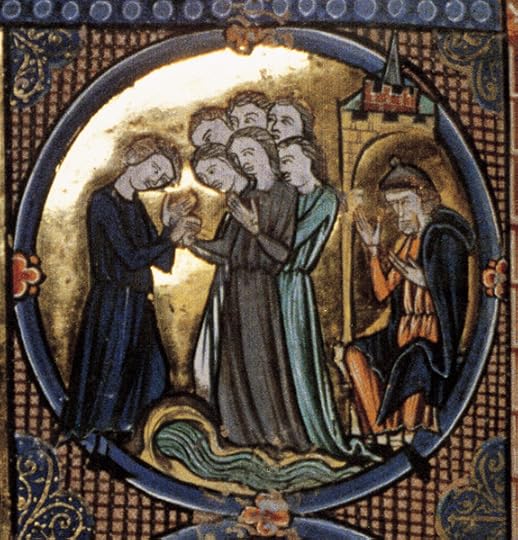 Bodelian Library, Oxford, MS Bodley 2708, Folio 39V
Bodelian Library, Oxford, MS Bodley 2708, Folio 39VA good man? Moses’ father-in-law, Jethro, is a devoted family man, well respected for his advice on governing and his benevolent leadership of the tribes of Midian. This early 13th-century illustration from the Bible moralisée depicts Jethro (seated under the arch on the right) rewarding Moses (left) for rescuing his daughters (six of whom are pictured in the center) and their flocks from rival shepherds.
Jethro, to most people, was the not-so-bright son of Jed and Granny on “The Beverly Hillbillies.” How many realize that Jethro was the name of Moses’ father-in-law? Jethro was “priest and prince of Midian,” the area where Moses encountered the Burning Bush.
Jethro comes to Moses in the wilderness of Sinai, before the giving of the Ten Commandments, because he is bringing his daughter–Moses’ wife–back to him. Although the text does not tell us this earlier, she evidently took their children and went to her father for safekeeping during Moses’ confrontation with Pharoah; when Moses tells Jethro everything the Lord did for the people, including the plagues, this is all news to Jethro. If his daughter had seen any of this, she would have told him; evidently, she left Moses in Egypt before the plagues began. In thanksgiving for the deliverance of the people, Jethro offers a large sacrifice and invites all the clan leaders to the feast that follows.
The text tells us that Jethro is priest-and-prince. We already knew that he was wealthy because of the description of his large flocks when Moses first meets him. Whether Jethro was a wealthy herdsman who was therefore acknowledged as “prince” or was the prince and therefore was wealthy, we don’t know. But the linkage of royalty and priesthood only occurs one other time in the Old Testament: the priest-king Melchizedek who blesses Abraham and is seen as a “type” of Christ by the Epistle to the Hebrews.
Medieval rabbis were eager to avoid the embarrassment of Moses having a pagan priest-prince as a father-in-law and so they began to suggest that Jethro was circumcised after he heard the recitation of God’s mighty acts of deliverance–after he heard what became the Passover haggadah, in effect. This made Jethro, like Melchizedek, a legitimate priest before Aaron and his sons were made a legitimate priesthood. This makes Jethro, like Melchizedek, a foreshadowing of Christ–the Son of David who is both priest and king on the Cross. Jethro, however, was not the focus of the typology in the Epistle to the Hebrews because he did not evidently live forever, like Melchizedek did; Jethro was an imperfect type of Christ, the ultimate king-priest who is eternal.
Nevertheless, this makes for fascinating speculation about Moses–raised as a prince of Egypt– and his immediate family as Middle Eastern royalty and their connection to priesthood in both Moses’ father-in-law (Jethro) and his brother (Aaron).
The post Jethro and Moses … and Christ appeared first on Stephen Morris, author.
July 25, 2023
Apostolic Invitations
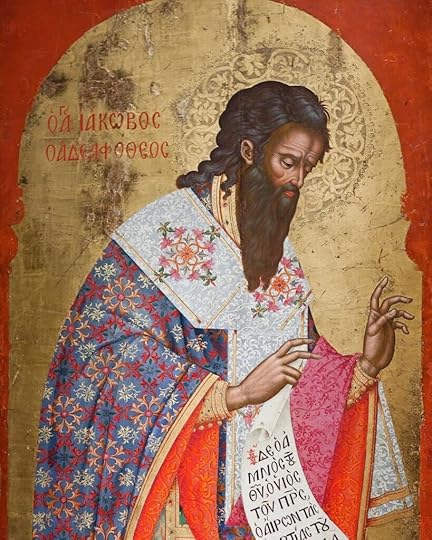 Apostle James, brother of St. John the Theologian (the Divine)
Apostle James, brother of St. John the Theologian (the Divine)We celebrate the feast of the Apostle James on Tuesday, July 25th. He was a very popular saint in the Middle Ages and his shrine at Compostela in Spain was one of the most popular pilgrimage destinations in Europe. (The pilgrimage has become popular again in recent decades and several Episcopalians from New York have made the pilgrimage—some, several times!—in the last few years.) Learn more about St. James the Apostle in the photo above.
St. James was an apostle, a preacher of the Good News of Jesus Christ. He spent his life traveling and sharing the message of Christ with others. He was killed because he would not deny his faith in Christ. We are likewise called to share our faith and in Christ with other people—not necessarily by traveling around the world and talking to strangers but by talking to the people we already know who live right around us already.
Our faith is important to each of us in personal and unique ways. We might feel foolish or embarrassed to discuss these reasons with people we know but we should not be embarrassed to invite people to come to church with us. If we want our parish to grow and thrive, flourish and outlive any of us who are currently the community of Good Shepherd, we need to invite people to join us on Sunday morning or at a weekday event. There are plenty to choose from.
We don’t need to wait for a special event. Every Sunday is special in some way—the music, the sermon, the fellowship at Coffee Hour. Who might you invite to join us on Sunday, September 17 when the choir returns from their summer hiatus?
We should be praying for our neighbors as well as inviting them to come to Good Shepherd with us. Our prayers for the welfare of those around us can help us—and our neighbors—be more open and responsive to opportunities for sharing faith. We can also invite friends or neighbors to view our Facebook Live broadcasts or recordings to familiarize themselves with our community before they actually step through the doors on East 31st Street. Such online evangelism is just as valuable as evangelism on the street or in the laundry room.
We believe “in one, holy, Catholic, and apostolic Church.” That means the Church is directly connected to the apostles and shares the same calling as the apostles. That means that each of us personally—because we are members of the Body of Christ, that one, holy, Catholic, and apostolic Church—also share that same calling among our neighbors and friends. We can use the feast of St. James as a reminder of our callings to be apostles just as he was.
Read previous blogs about more of the Apostle James’ adventures in Spain here.
The post Apostolic Invitations appeared first on Stephen Morris, author.
July 11, 2023
Dare to Touch
 The healing of the bleeding woman, Rome, Catacombs of Marcellinus and Peter, 4th-century.
The healing of the bleeding woman, Rome, Catacombs of Marcellinus and Peter, 4th-century.… a synagogue leader came and knelt before him and said, “My daughter has just died. But come and put your hand on her, and she will live.” Jesus got up and went with him, and so did his disciples.
Just then a woman who had been subject to bleeding for twelve years came up behind him and touched the edge of his cloak. 21 She said to herself, “If I only touch his cloak, I will be healed.” (Matt. 9)
The woman with the 12-years hemorrhaging had been bleeding for as long as the dead 12-year old had been alive. Blood and life. 12 apostles. 12 tribes of Israel. Life vs Death. The life of the Kingdom vs fallen life in a fallen world. The episodes of the girl and the woman are short hand for the Gospel in so many ways.
The hemorrhaging woman is frequently cited in prayers in preparation for Holy Communion. We see ourselves in her: as she dared to reach out to touch Christ’s garment, hoping to be healed, we dare to reach out to receive his body and blood, hoping to be healed as well. Healed. Raised from the dead. Healed, aka “saved.” (Both words are derived from the same root in Greek.)
We “are bold” to say Our Father before Communion. Do we realize how daring it is to reach out, making a throne with our palms to receive the King of Kings? We frequently do this pro forma, unthinkingly, out-of-habit. But if we were truly awake, would we dare?
This woman, traditionally known as Berenice, is possibly also the woman known as Veronica who is said to have wiped Christ’s face with a cloth which was then marked with the image of his face. (Veronica and Bernice are both names derived from the same Phoenician root.) Both stories—Bernice and Veronica—are about daring to reach out, daring to touch. About cloth.
The Word of God clothes himself in human flesh. He dares to reach out towards us, inviting us to reach out to him. He dares to touch us in our grief, isolation, need. He welcomes our touch in return.
The post Dare to Touch appeared first on Stephen Morris, author.
June 27, 2023
Judge Not? Humble Access
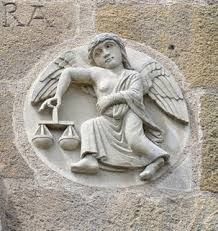 Medieval angel holding scales of justice, illustrating Libra, the constellation of scales in the zodiac.
Medieval angel holding scales of justice, illustrating Libra, the constellation of scales in the zodiac.Judge not, lest you be judged. You will be judged by the same standards that you use to judge other people. The measure you use will be used to measure you. (Matt. 7)
Does Jesus mean, “Don’t hold anyone accountable?” Does he mean, “Don’t have any standards?” Does he mean, “Let people get away with everything?” Of course not!
St. Joseph, the foster father of Jesus and the righteous man betrothed to the Mother of God, was prudent. He took his family to Egypt to escape the murderous intent of King Herod when Jesus was 2 years old and he brought his family back to Israel when King Herod died but he didn’t just go back to the village they had lived in before. He took them to live somewhere else because Herod’s son–who was worse than his father!–was ruling over their old hometown. St. Joseph certainly used his judgement, his common sense, and prudence to decide what to do in each situation. He did not bury his head in the sand and pretend to not see what was as plain as day for the safety of his family.
Jesus is not telling us to hold no one accountable. He’s telling us to hold ourselves accountable to the same standards we use to hold everyone else accountable. Maybe I have every excuse in the book to explain why I am late–the subway went out of service, it was pouring rain, there were no taxis, the bus got stuck in traffic–but then I get furious when someone else is late and makes me wait. Maybe I want to through someone in proverbial jail when they do something that I allow myself to do all the time. Maybe I am always the victim. Maybe it’s never my fault. Is that realistic? Is that honest?
Being honest is not about masochism and beating ourselves up for things we think we can’t help. It’s a simple statement of fact, like the opening lines of the Prayer of Humble Access:
We do not presume to come to this thy table, O merciful Lord, trusting in our own righteousness but in thy manifold and great mercy. We are not worthy so much as to gather up the crumbs from under thy table ….
This is not masochistic wallowing in guilt; it is a simple statement of fact.
Jesus is telling us to be humane. He’s telling us to be human. He’s telling us to be honest and admit that we fall short of our own standards and can’t expect other people to live up to standards or follow rules that we can’t–or simply choose not to–follow. He’s underscoring the importance of holding ourselves accountable the same way we want to hold everyone else accountable: “Our Father …. forgive us our trespasses as we forgive those who trespass against us.”
 From the writing of Dorothy Day
From the writing of Dorothy DayThe post Judge Not? Humble Access appeared first on Stephen Morris, author.
June 19, 2023
“Today, you will be with me in Paradise”
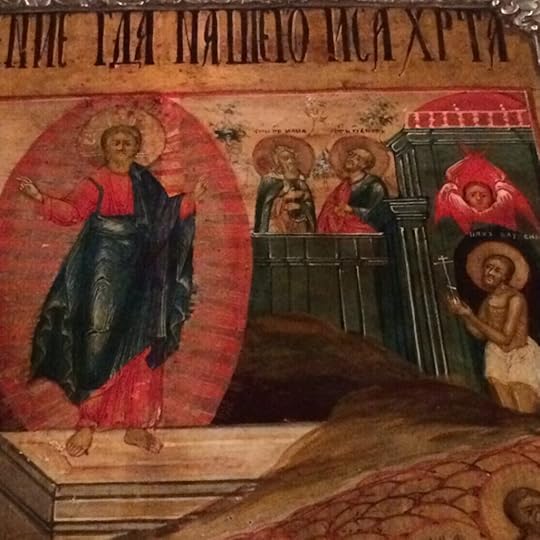 Christ risen from the dead with the Good Thief about to enter Paradise, showing the cross to the flaming cherubim guarding the gates, as his “admission ticket.”
Christ risen from the dead with the Good Thief about to enter Paradise, showing the cross to the flaming cherubim guarding the gates, as his “admission ticket.”“Today,you will be with me in paradise.” If we approach the chalice with the self-examination,the reorientation of our lives, the words of the thief—Remember me in your kingdom—Christmakes the same promise to us: Today you will be with me in paradise. Today youwill begin to live forever.
What does that even mean, that we will be “with him in paradise,” that we “will live forever?” We sometimes think that eternal life is just like the life we know now… but rather than walking around on earth for some finite period, we will be walking around paradise for “an eternity,” that time will simply be stretched out and stretched out and simply go on much like it does now on earth but without ever having an end in sight.
But eternity—the “forever” of the Kingdom of God—is not simply a very long time that simply never stops. “Eternity” and “eternal life” is simply always NOW. There is no time—not long, not short, not never-ending—just NOW and its quality is as different from what we currently experience as life in the womb differs from life after we are born. It’s impossible for us to understand what eternity and paradise are like just as it is impossible for a baby in the womb to know what to expect when it emerges out into the world.
The post “Today, you will be with me in Paradise” appeared first on Stephen Morris, author.
June 13, 2023
Corpus Christi 2023, part 2




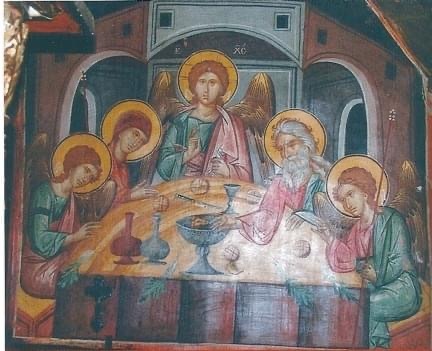 An icon of Christ as celebrant of the Eucharist, with the four evangelists and four bishops—SS. John Chrysostom, Basil the Great, James of Jerusalem, Gregory the Great—credited with composing the four Eucharistic services of the Orthodox Church; the Holy Gifts on the altar; the anaphora on Low Sunday; the elevation at Low Mass during Easter Week; the hospitality of Abraham hosting the three angels, a “type” of the Eucharist.
An icon of Christ as celebrant of the Eucharist, with the four evangelists and four bishops—SS. John Chrysostom, Basil the Great, James of Jerusalem, Gregory the Great—credited with composing the four Eucharistic services of the Orthodox Church; the Holy Gifts on the altar; the anaphora on Low Sunday; the elevation at Low Mass during Easter Week; the hospitality of Abraham hosting the three angels, a “type” of the Eucharist.One of things that scared those who denied Christ’s presence in the Eucharist was that if true—if Christ is really and truly present somehow in the Eucharistic bread and wine—then how could anyone dare to receive it? How could anyone of us dare to stretch out their hands or open their mouths unless they were as pure as the angels themselves?
Taking St. Paul’s admonition seriously, without discerning the body—without adequate self-examination and preparation to receive the Eucharist—a person would be eating and drinking judgement on themselves. And the people who denied that Christ is present in the Eucharist weren’t wrong to be frightened. It is an awesome thing to dare to reach out and touch—much less, consume!—the bread of the Eucharist if it truly is Corpus Christi, the Body of Christ.
But St. Paul didn’t say the Corinthians had to be pure or sinless. He said they had to be worthy. Worthiness is a very different thing. To be worthy to touch, to be worthy to consume the Body of Christ does not mean to be sinless. As several English theologians in the 1600s and 1700s pointed out, to be worthy is to be committed to self-examination, committed to repentance, committed to always turning around, changing direction, re-orienting myself towards Christ.
So I must always prepare to approach the Table by examining myself, reviewing what I have done and who I have been during the time since I last approached the Holy Table. Examine myself, measure myself against our standard—which is Christ—and determine how I might, in perhaps some single small way, turn my back on that person that I do not want to be and take some small step closer to being the person I was made to be in Christ.
To be worthy of receiving Holy Communion, to dare to touch the Corpus Christi, I must be committed to self-examination and repentance. One of those English theologians, Simon Patrick[1] in 1660, suggested using a phrase from the Gospel that Greek and Russian Christians use as they approach the chalice: “Lord, remember me when you come in your kingdom.”
The thief crucified with Christ acknowledged Jesus as Lord and reoriented his life—turning his back on his image of himself as a victim who was owed whatever he could take from other people—and he asked Jesus to make a place for him in the Kingdom. What was Jesus’ answer? “Today, you will be with me in paradise.” If we approach the chalice with the self-examination, the reorientation of our lives, the words of the thief—Remember me in your kingdom—Christ makes the same promise to us: Today you will be with me in paradise. Today you will begin to live forever.
[1]Bishop of Ely, Mensa Mystica, or a Discourse concerning the Sacrament of theLord’s Supper. (Prayer Book Spirituality, p. 283)
The post Corpus Christi 2023, part 2 appeared first on Stephen Morris, author.
June 6, 2023
Corpus Christi = Triumph of Orthodoxy
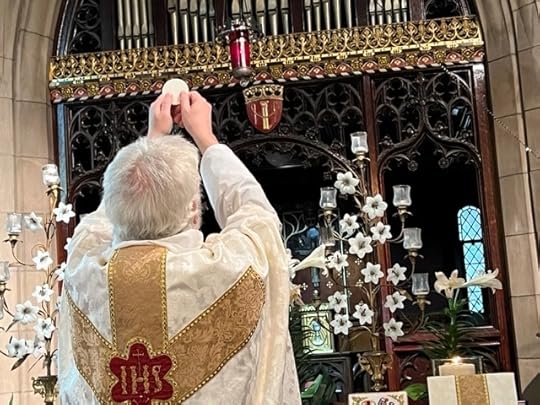
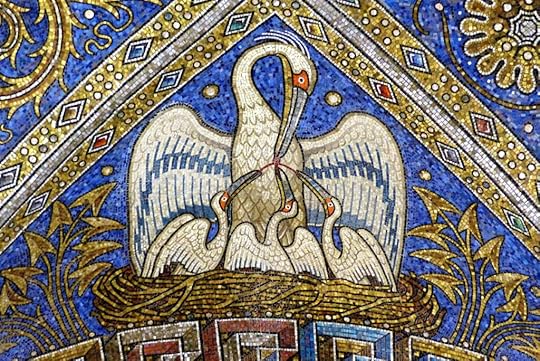
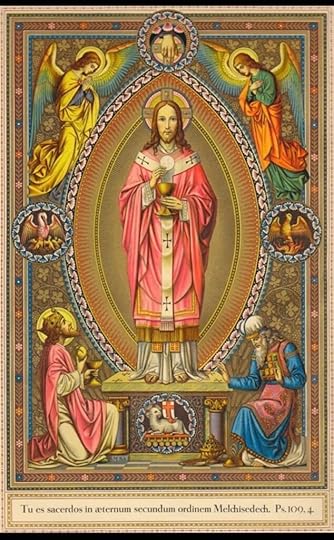 Scenes related to Corpus Christi: the elevation of the Host at Mass; the pelican’s piety, piercing her own breast with her beak in order to raise her chicks from the dead with the blood of her pierced breast; an image of Christ the priest-and-king, offering the Host and Chalice.
Scenes related to Corpus Christi: the elevation of the Host at Mass; the pelican’s piety, piercing her own breast with her beak in order to raise her chicks from the dead with the blood of her pierced breast; an image of Christ the priest-and-king, offering the Host and Chalice.Twice the Christian Church has been overwhelmed by controversy about whether God can be present in or act through material things.
The first time was in the ChristianEast, when the iconoclasts insisted that icons should be destroyed, not merelynot venerated. You can read about all the dates and details in a book. Theimportant thing to know is that the iconoclasts systematically leveled churchesthat were adorned with icons and dissolved monasteries, confiscating monasticproperty because the monks led the resistance against the iconoclastic effortsto wipe out icons. Finally, in AD 843, the icons were restored to the greatcathedral of Hagia Sophia in Constantinople and a massive procession was held.People carried icons large and small through the streets of the imperialcapital to celebrate the vindication of the icons, the triumph of Orthodoxy asit is still referred to, and every year on the first Sunday of Lent—theanniversary of that massive procession—each parish of the Greek and RussianChurches celebrates the Triumph of Orthodoxy again, processing with icons atleast around the aisles of the church if not through the streets of the city.
The second time the Christian Churchwas torn apart by the controversy about whether God can be present in or atthrough material things was in the Christian West. You can read about thedetails of these Eucharistic controversies in books as well; the importantthing being that these continued on and off for nearly 400 years. The WesternChurch was torn by riots between those who did vs. those who did not believethat Christ is truly present in the Eucharist. It was not until AD 1215 thatthe question was settled that yes, indeed, Christ IS truly present in theEucharist and in 1246 a nun, Juliana, organized a procession with the BlessedSacrament through the streets of a city in Belgium to celebrate Christ’spresence in the Eucharistic bread.
In both cases—the iconoclasticcontroversy in the East and the eucharistic controversy in the West—the disputewas about whether God can be truly present in material objects and whether itis appropriate to offer incense, prayers, and proskynesis (prostrations and genuflections). In both cases, theChurch acknowledged that God can be present in material things because Godhimself was made flesh in the womb of the great Mother of God, Mary most holy and—inboth cases—that incense, prayers, and genuflections are appropriate recognitionof the presence of God. And in both cases people began to hold processionsthrough the streets with the material objects that were at the heart of thecontroversies… icons in the east, the Eucharist in the west.
We hold processions through the streets with icons or the Eucharist to celebrate God’s blessing on the world in general and on our neighborhood in particular. We acclaim the Eucharist and offer our worship—music, incense, singing, kneeling and genuflecting—to recognize and celebrate God’s presence with us. God is with us and what else can we do but sing like the angels and bow down with our faces to the ground?
We should-we must carry the Eucharist in procession to celebrate that God is with us. Even here. Even now. But we should-we must examine ourselves, turning ever more completely toward the God who gives himself for us. Even here. Even now. And we should-we must forgive and embrace the neighbor that we find beside us—whether we like them or not—if we hope to experience the NOW of eternity as abundant, inexpressible joy. Even here. Even now.
My most popular post was also about Corpus Christi—almost 1,000 people viewed it on the day it was published! Read it here.
The post Corpus Christi = Triumph of Orthodoxy appeared first on Stephen Morris, author.
May 31, 2023
Ember Days


 Celebrating the Sung Mass on Pentecost at the Church of the Good Shepherd, Kips Bay (photos courtesy of Kate Stronk)
Celebrating the Sung Mass on Pentecost at the Church of the Good Shepherd, Kips Bay (photos courtesy of Kate Stronk)Ember days. Days of prayer for those preparing for ordination, days for celebrating ordination, days of prayer for those engaged in ordained ministry. Three days of fasting and prayer—Wednesday, Friday, Saturday—are set aside four times a year (the week of Pentecost, the week following Holy Cross Day, the week following St. Lucy’s Day in December, the first full week of Lent) in order to pray for and ordain clergy to sustain the life of the Body of Christ.
But—Ember Days are also the source of Tempura! Tempura is a typical Japanese dish that was originally introduced to Japan by the Portuguese in Nagasaki through fritter-cooking techniques during the 16th century. The dish usually consists of seafood, meat and vegetables that have been battered and deep fried. Who’d athunk it?!
The word tempura comes from the original Latin for the Ember Days; the term “Ember Days” itself comes from the Latin quatuor tempora (literally ‘four times’). The Ember Days are also regular times to avail oneself of Confession and spiritual direction at the four turning points of the seasons. Tying self-examination, repentance, confession, etc to the Ember Days removes these from the realm of “whether I feel it’s necessary” and waiting for a moment of “inspiration” so that such activities become simply part of the regular, expected rhythm of spiritual life and practice.
Some people see a connection between the Ember Days and the four Lenten periods of the Orthodox Church year—Nativity Fast, Great Lent, the Apostles’ Fast, and the Dormition Fast. Although falling at similar times of the year, there is no firm connection between the Ember Days and these Orthodox fasting periods. But the four Lenten periods are also times of prayer and fasting, spiritual guidance and confession, as well as frequently occasions for ordination.
Spanish folklore says the weather of the Ember Days predicts the weather for that coming season of the year, much as the folklore of Groundhog Day says the weather of February 2 sets the pattern for the next six weeks. (That means the summer will be pleasant and mild, at least in New York!  )
)
So, four times a year for three days: Fast! Pray! Confess! Be ordained! And eat tempura ….
The post Ember Days appeared first on Stephen Morris, author.



